When people first learn about barefoot shoes, they always ask: Are you talking about those funny shoes with the five fingers? Should my kids be wearing those?
Yes. Those are barefoot shoes. But barefoot shoes come in different styles.
The other question is: I already buy my kids “Brand X” shoes which come with many bells and whistles. What’s so great about barefoot shoes?
Think you have all the answers? We explore many of the myths surrounding children’s shoes. Most of these apply to adult shoes, as well, but, since kids’ feet are still growing, the consequences are amplified.
1. Myth: Shoe Shape is not Important
The concept of how a shoe is shaped is usually not a deciding factor when parents buy shoes for their children.
But it should be.
Should feet conform to the shape of shoes or the other way around? When posing the question like this, it’s obvious that shoes should be foot-shaped.
When shoes have a wide toe box, toes are not locked in. They are able to spread out. Feet are able to grow naturally, not growing to accommodate narrow shoes.
Wide toe-box shoes reduce the occurrence of painful adult foot problems like hammer-toes and bunions. Growing feet benefit the most by the freedom provided by optimally designed wide-toe-box shoes.
2. Myth: Stiff-Soled Shoes are a Must for Support
Stiff-soled shoes do one thing great: to restrict movement of the foot.
How could that be good?
Restricting movement causes growing feet to use the muscles of the feet less. There is no bending, no twisting. Only rigidity.
It is ideal for children to wear flexible shoes. Where stiff-soled shoes promote atrophy of the muscles - Flexible shoes strengthen the feet. Flexible shoes don’t restrict movement. They mimic the natural way feet should be moving.
3. Myth: Shoes Need Padding and Arch Support
Traditional children’s shoes have padding. The purpose of padding is to protect the feet from the shocks of walking and running.
So… Is arch support and padding necessary?
a. Arch support, the extra protruding padding in the middle of the shoe is there to “protect” the arch of the foot. Padding and support actually weaken the foot. Barefoot shoes with thin soles and no support mimic the natural way of movement. They also encourage children to control impact and therefore eliminate the need for all the padding.
b. Padding and support shield children from feeling the ground.
There are over 100,000 nerve endings in the feet. Thin soles provide feedback from the ground. More padding creates less feedback. Less feedback encourages sloppy and mindless movement. Who wants that?
4. Myth: The Heel of Shoe Should be Padded
Typical shoes are not flat. Most of them have some padding or an elevated heel. The false reasoning behind this is to remove pressure from the heel and have more foot support.
But in reality, a padded heel shortens the Achilles tendon, encourages heel striking, and changes the child’s gait.
Let’s break this down.
a. A flat shoe makes the foot muscles work properly. Elevated shoes do the opposite. When the muscles aren’t used they become weaker and shorten.
b. Flat shoes, with the same thickness from heel to heel encourage the natural way of walking and running where the forefoot and midfoot strike the ground.
A padded heel has no feedback from the ground. And since the heel is elevated, the heel is the main point of the foot striking the ground.
Why is this bad? It shifts the pressure to the knees and hips.
c. Flat shoes mimic the way children move when barefoot. Putting this all together, the combination of padded shoes affecting the Achilles tendon and heel striking completely change the gait of children.
Now that you know the truth behind these myths, selecting the optimum shoes for our children should be easier.
Zuna barefoot shoes are ideal for growing feet because they are
(1) flexible
(2) have thin sole
(3) zero-drop soles and a
(4) wide-toe-box.
All the features in one package to promote the growth of healthy young feet.
Yes. Those are barefoot shoes. But barefoot shoes come in different styles.
The other question is: I already buy my kids “Brand X” shoes which come with many bells and whistles. What’s so great about barefoot shoes?
Think you have all the answers? We explore many of the myths surrounding children’s shoes. Most of these apply to adult shoes, as well, but, since kids’ feet are still growing, the consequences are amplified.
1. Myth: Shoe Shape is not Important
The concept of how a shoe is shaped is usually not a deciding factor when parents buy shoes for their children.
But it should be.
Should feet conform to the shape of shoes or the other way around? When posing the question like this, it’s obvious that shoes should be foot-shaped.
When shoes have a wide toe box, toes are not locked in. They are able to spread out. Feet are able to grow naturally, not growing to accommodate narrow shoes.
Wide toe-box shoes reduce the occurrence of painful adult foot problems like hammer-toes and bunions. Growing feet benefit the most by the freedom provided by optimally designed wide-toe-box shoes.
2. Myth: Stiff-Soled Shoes are a Must for Support
Stiff-soled shoes do one thing great: to restrict movement of the foot.
How could that be good?
Restricting movement causes growing feet to use the muscles of the feet less. There is no bending, no twisting. Only rigidity.
It is ideal for children to wear flexible shoes. Where stiff-soled shoes promote atrophy of the muscles - Flexible shoes strengthen the feet. Flexible shoes don’t restrict movement. They mimic the natural way feet should be moving.
3. Myth: Shoes Need Padding and Arch Support
Traditional children’s shoes have padding. The purpose of padding is to protect the feet from the shocks of walking and running.
So… Is arch support and padding necessary?
a. Arch support, the extra protruding padding in the middle of the shoe is there to “protect” the arch of the foot. Padding and support actually weaken the foot. Barefoot shoes with thin soles and no support mimic the natural way of movement. They also encourage children to control impact and therefore eliminate the need for all the padding.
b. Padding and support shield children from feeling the ground.
There are over 100,000 nerve endings in the feet. Thin soles provide feedback from the ground. More padding creates less feedback. Less feedback encourages sloppy and mindless movement. Who wants that?
4. Myth: The Heel of Shoe Should be Padded
Typical shoes are not flat. Most of them have some padding or an elevated heel. The false reasoning behind this is to remove pressure from the heel and have more foot support.
But in reality, a padded heel shortens the Achilles tendon, encourages heel striking, and changes the child’s gait.
Let’s break this down.
a. A flat shoe makes the foot muscles work properly. Elevated shoes do the opposite. When the muscles aren’t used they become weaker and shorten.
b. Flat shoes, with the same thickness from heel to heel encourage the natural way of walking and running where the forefoot and midfoot strike the ground.
A padded heel has no feedback from the ground. And since the heel is elevated, the heel is the main point of the foot striking the ground.
Why is this bad? It shifts the pressure to the knees and hips.
c. Flat shoes mimic the way children move when barefoot. Putting this all together, the combination of padded shoes affecting the Achilles tendon and heel striking completely change the gait of children.
Now that you know the truth behind these myths, selecting the optimum shoes for our children should be easier.
Zuna barefoot shoes are ideal for growing feet because they are
(1) flexible
(2) have thin sole
(3) zero-drop soles and a
(4) wide-toe-box.
All the features in one package to promote the growth of healthy young feet.

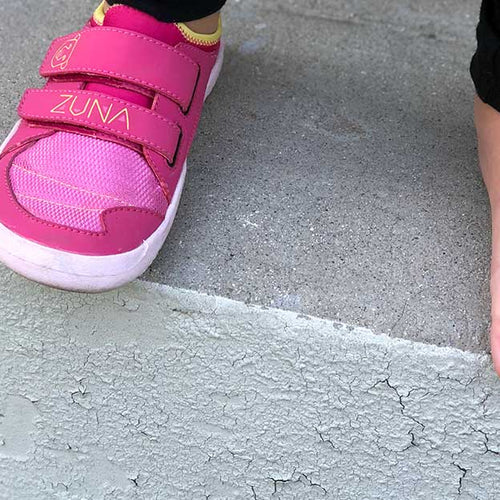

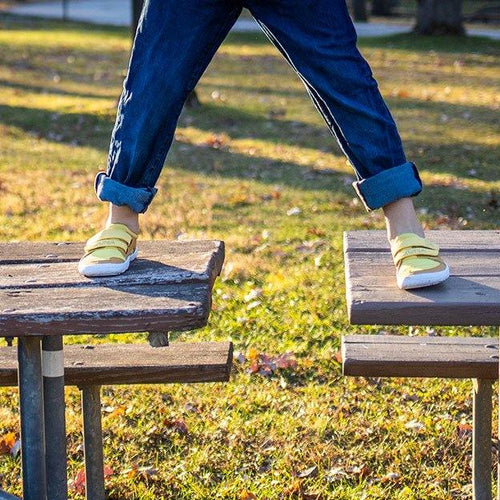
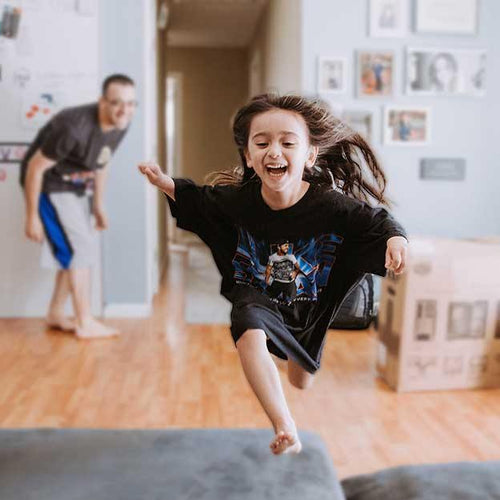
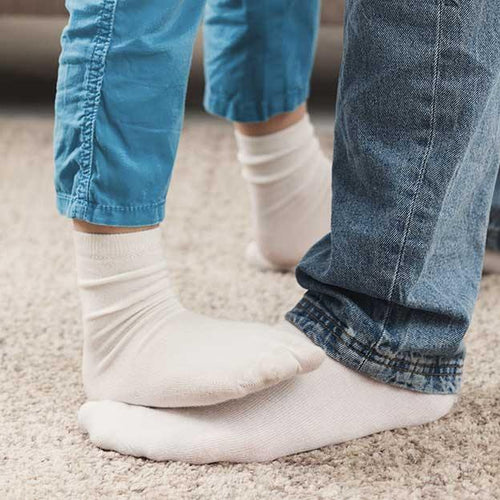

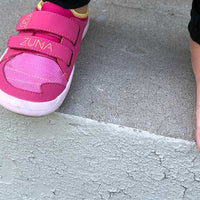

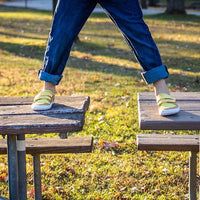

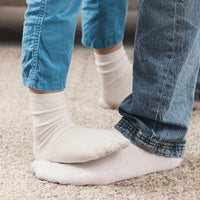
0 comment